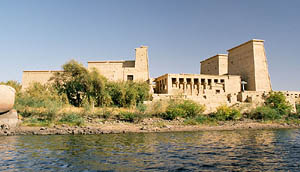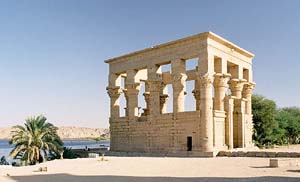Temple of Philae
Philae or Pilak or P'aaleq (Egyptian: remote place
or the end or the angle island) or Arabic: Anas el Wagud, is
an island in the Nile River and the previous site of an Ancient
Egyptian temple complex in southern Egypt. The complex is now
located on the nearby island of Agilika.
Construction
 |
| Temple
of Philae |
The most conspicuous feature of both islands was
their architectural wealth. Monuments of very various eras,
extending from the Pharaohs to the Caesars, occupy nearly
their whole area. The principal structures, however, lay at
the south end of the smaller island. The most ancient were
the remains of a temple of Athor (Aphrodite), built in the
reign of Nectanebus. The other ruins date for the most part
from the Ptolemaic times, more especially with the reigns
of Ptolemy Philadelphus, Ptolemy Epiphanes, and Ptolemy Philometor
(282-145 BC), with many traces of Roman work as recent in
Philae, dedicated to Ammon-Osiris, was appreached from the
river through a double colonnade. In front of the propyla
were two colossal lions in granite, behind which stood a pair
of obelisks, each 44 feet high. The propyla were pyramidal
in form and colossal in dimensions. One stood between the
dromos and pronaos, another between the pronaos and the portico,
while a smaller one led into the sekos or adytum. At each
corner of the adyturn stood a monolithal shrine, the cage
of a sacred hawk. Of these shrines one is now in the Louvre,
the other in the Museum at Florence. Right left of the entrance
into the principal court are small temples or rather chapels,
one of which, dedicated to Athor, is covered with sculptures
representing the birth of Ptolemy Philometor, under the figure
of the god Horus. The story of Osiris is everywhere represented
on the walls of this temple, and two of its inner chambers
are particularly rich in symbolic imagery. Upon the two great
propyla are Greek inscriptions intersected and partially destroyed
by Egyptian figures cut across them. The inscriptions belong
to the Macedonian era, and are of earlier date than the sculptures,
which were probably inserted during that interval of renaissance
for the native religion which followed the extinction of the
Greek dynasty in Egypt. (30 BC) The monuments in both islands
indeed attested, beyond any others in the Nile-valley, the
survival of pure Egyptian art centuries after the last of
the Pharaohs had ceased to reign. Great pains have been taken
to mutilate the sculptures of this temple. The work of demolition
is attributable, in the first instance, to the zeal of the
early Christians, and afterwards to the policy of the Iconoclasts,
who curried favour for themselves with the Byzantine court
by the destruction of heathen as well as Christian images.
 |
Trajan's Kiosk inside
the temple of Philae |
The soil of Philae was carefully prepared for the
reception of its buildings – being levelled where it was uneven,
and supported by masonry where it was crumbling or insecure.
For example, the western wall of the Great Temple, and the
corresponding wall of the dromos, were supported by very strong
foundations, built below the pre-inundation level of the water,
and rested on the granite which in this region forms the bed
of the Nile. Here and there steps were hewn out from the wall
to facilitate the communication between the temple and the
river.
At the southern extremity of the dromos of the Great
Temple was a smaller temple, apparently dedicated to Isis;
at least the few columns that remained of it are surmounted
with the head of that goddess. Its portico consisted of twelve
columns, four in front and three deep. Their capitals represented
various forms and combinations of the palm-branch, the dhoum-leaf,
and the lotus-flower. These, as well as the sculptures on
the columns, the ceilings, and the walls, were painted with
the most vivid colors, which, owing to the dryness of the
climate, have lost little of their original brilliance.